ATHC 1 Assessment Three (3) template
VerifiedAdded on 2022/11/18
|8
|1851
|269
AI Summary
Complete the Clinical Reasoning Cycle for Mr Cyril Smith using the information provided. Also, answer critical thinking questions related to safe medication practices and effective therapeutic communication.
Contribute Materials
Your contribution can guide someone’s learning journey. Share your
documents today.
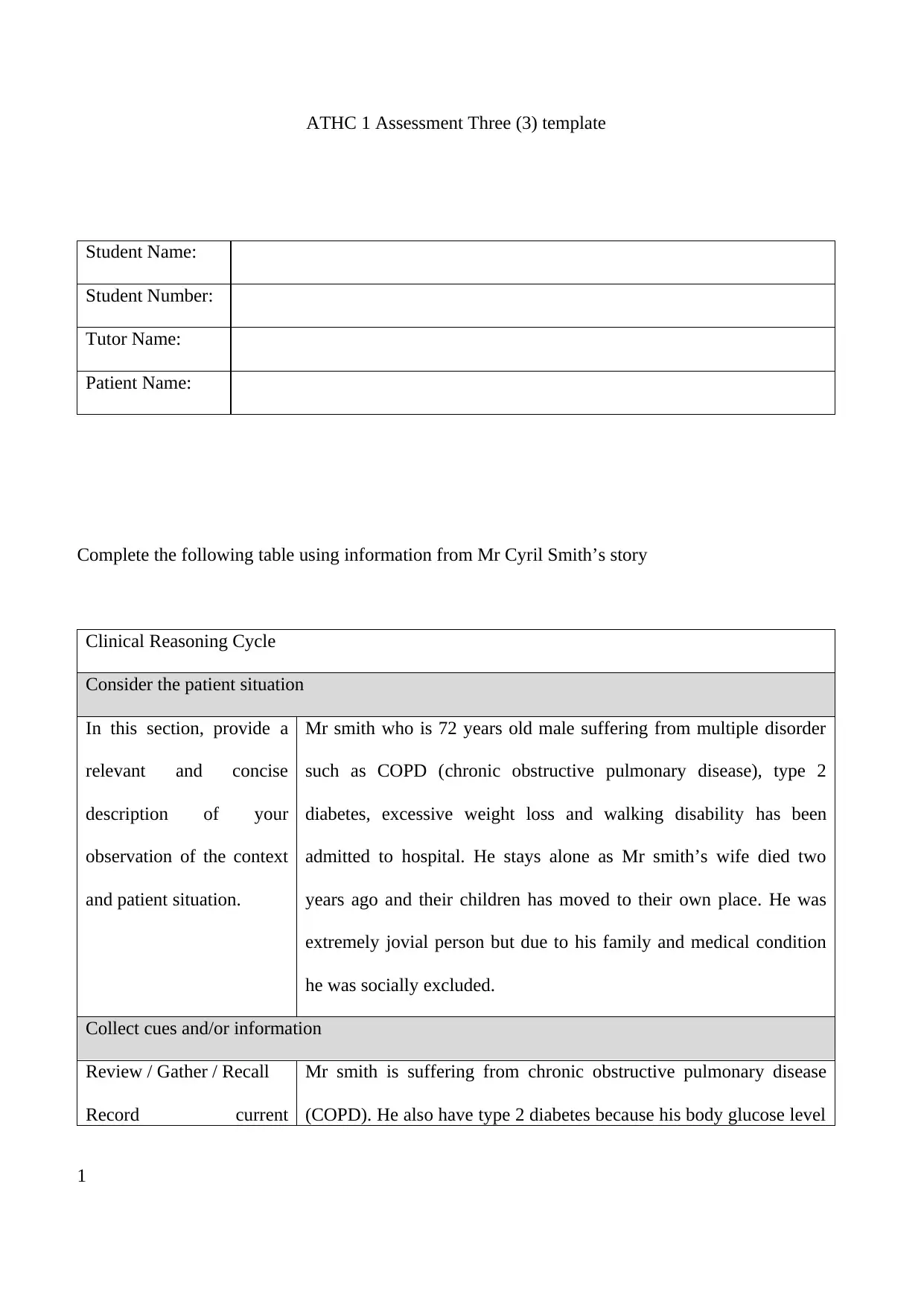
ATHC 1 Assessment Three (3) template
Student Name:
Student Number:
Tutor Name:
Patient Name:
Complete the following table using information from Mr Cyril Smith’s story
Clinical Reasoning Cycle
Consider the patient situation
In this section, provide a
relevant and concise
description of your
observation of the context
and patient situation.
Mr smith who is 72 years old male suffering from multiple disorder
such as COPD (chronic obstructive pulmonary disease), type 2
diabetes, excessive weight loss and walking disability has been
admitted to hospital. He stays alone as Mr smith’s wife died two
years ago and their children has moved to their own place. He was
extremely jovial person but due to his family and medical condition
he was socially excluded.
Collect cues and/or information
Review / Gather / Recall
Record current
Mr smith is suffering from chronic obstructive pulmonary disease
(COPD). He also have type 2 diabetes because his body glucose level
1
Student Name:
Student Number:
Tutor Name:
Patient Name:
Complete the following table using information from Mr Cyril Smith’s story
Clinical Reasoning Cycle
Consider the patient situation
In this section, provide a
relevant and concise
description of your
observation of the context
and patient situation.
Mr smith who is 72 years old male suffering from multiple disorder
such as COPD (chronic obstructive pulmonary disease), type 2
diabetes, excessive weight loss and walking disability has been
admitted to hospital. He stays alone as Mr smith’s wife died two
years ago and their children has moved to their own place. He was
extremely jovial person but due to his family and medical condition
he was socially excluded.
Collect cues and/or information
Review / Gather / Recall
Record current
Mr smith is suffering from chronic obstructive pulmonary disease
(COPD). He also have type 2 diabetes because his body glucose level
1
Secure Best Marks with AI Grader
Need help grading? Try our AI Grader for instant feedback on your assignments.

information, new
information, knowledge
is 7.2 mmol which is more than the normal blood glucose level (less
than 6.9). Instead of that he usually skips his diabetes medicine. Due
to fracture in his ankle which happened around fifteen years ago, he
is suffering from walking disability and hence needs assistance of his
walking aids but then also he manages all his activities of daily living
by himself. He was also diagnosed with bowel cancer and hence
suffering from excessive weight loss and reduced appetite. Airway
path is patent that is no obstruction observed. respiratory rate is 22
beats per minute, pulse rate is 120 beats per minute, oxygen status is
95%, blood pressure is 90/55, patient is oriented to place and time,
and reacts to PEARL (pupils are equal and reactive to light), measured
pain score is 3/10, body temperature is 37 degree Celsius, no wounds or
skin degradation observed, last void recorded at 09.00 and Bowel Gastric
And Intestine also observed. blood glucose level noted as 7.2mmol. His
daughter is going to visit at the afternoon.
Process Information
Interpret
Analyse data and come to
understanding of
signs/symptoms
Tachypnea is observed as his respiratory rate is 22 beats per minute
which is increased than the standard Respiratory Rate (12- 20 beats
per minute) and also has hypotension and his blood pressure is 90/55
due to which he is feeling woozy. Tachycardia is observe as the pulse
rate is 120 beats per minute which is also more than the normal pulse
rate according to his age due to his medical condition. His body
temperature is 37 degree Celsius which is normal. He is suffering
from type 2 diabetes due to which his body glucose level is increased
and is observed as 7.2 mmol and normal body glucose level (less than
2
information, knowledge
is 7.2 mmol which is more than the normal blood glucose level (less
than 6.9). Instead of that he usually skips his diabetes medicine. Due
to fracture in his ankle which happened around fifteen years ago, he
is suffering from walking disability and hence needs assistance of his
walking aids but then also he manages all his activities of daily living
by himself. He was also diagnosed with bowel cancer and hence
suffering from excessive weight loss and reduced appetite. Airway
path is patent that is no obstruction observed. respiratory rate is 22
beats per minute, pulse rate is 120 beats per minute, oxygen status is
95%, blood pressure is 90/55, patient is oriented to place and time,
and reacts to PEARL (pupils are equal and reactive to light), measured
pain score is 3/10, body temperature is 37 degree Celsius, no wounds or
skin degradation observed, last void recorded at 09.00 and Bowel Gastric
And Intestine also observed. blood glucose level noted as 7.2mmol. His
daughter is going to visit at the afternoon.
Process Information
Interpret
Analyse data and come to
understanding of
signs/symptoms
Tachypnea is observed as his respiratory rate is 22 beats per minute
which is increased than the standard Respiratory Rate (12- 20 beats
per minute) and also has hypotension and his blood pressure is 90/55
due to which he is feeling woozy. Tachycardia is observe as the pulse
rate is 120 beats per minute which is also more than the normal pulse
rate according to his age due to his medical condition. His body
temperature is 37 degree Celsius which is normal. He is suffering
from type 2 diabetes due to which his body glucose level is increased
and is observed as 7.2 mmol and normal body glucose level (less than
2
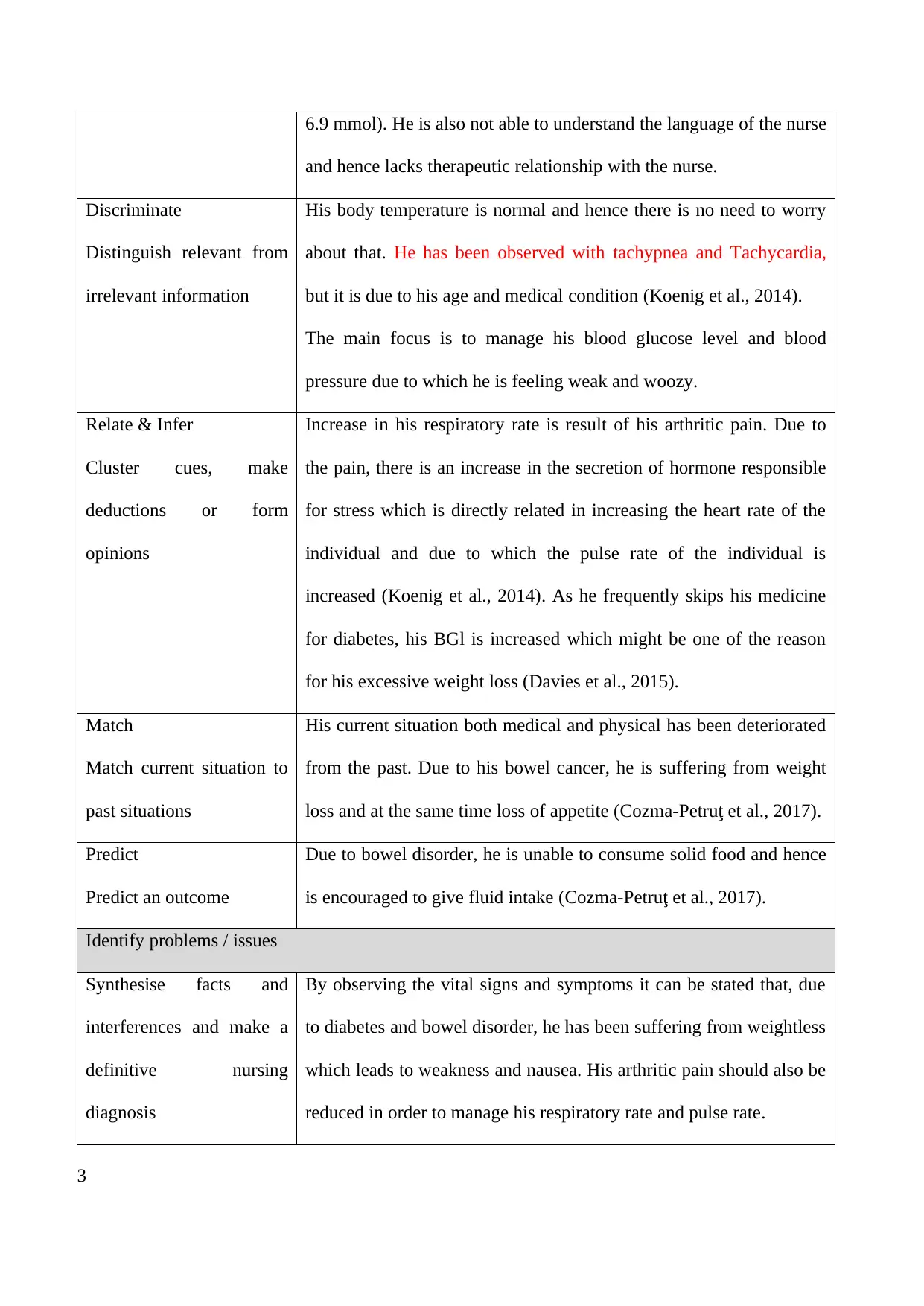
6.9 mmol). He is also not able to understand the language of the nurse
and hence lacks therapeutic relationship with the nurse.
Discriminate
Distinguish relevant from
irrelevant information
His body temperature is normal and hence there is no need to worry
about that. He has been observed with tachypnea and Tachycardia,
but it is due to his age and medical condition (Koenig et al., 2014).
The main focus is to manage his blood glucose level and blood
pressure due to which he is feeling weak and woozy.
Relate & Infer
Cluster cues, make
deductions or form
opinions
Increase in his respiratory rate is result of his arthritic pain. Due to
the pain, there is an increase in the secretion of hormone responsible
for stress which is directly related in increasing the heart rate of the
individual and due to which the pulse rate of the individual is
increased (Koenig et al., 2014). As he frequently skips his medicine
for diabetes, his BGl is increased which might be one of the reason
for his excessive weight loss (Davies et al., 2015).
Match
Match current situation to
past situations
His current situation both medical and physical has been deteriorated
from the past. Due to his bowel cancer, he is suffering from weight
loss and at the same time loss of appetite (Cozma-Petruţ et al., 2017).
Predict
Predict an outcome
Due to bowel disorder, he is unable to consume solid food and hence
is encouraged to give fluid intake (Cozma-Petruţ et al., 2017).
Identify problems / issues
Synthesise facts and
interferences and make a
definitive nursing
diagnosis
By observing the vital signs and symptoms it can be stated that, due
to diabetes and bowel disorder, he has been suffering from weightless
which leads to weakness and nausea. His arthritic pain should also be
reduced in order to manage his respiratory rate and pulse rate.
3
and hence lacks therapeutic relationship with the nurse.
Discriminate
Distinguish relevant from
irrelevant information
His body temperature is normal and hence there is no need to worry
about that. He has been observed with tachypnea and Tachycardia,
but it is due to his age and medical condition (Koenig et al., 2014).
The main focus is to manage his blood glucose level and blood
pressure due to which he is feeling weak and woozy.
Relate & Infer
Cluster cues, make
deductions or form
opinions
Increase in his respiratory rate is result of his arthritic pain. Due to
the pain, there is an increase in the secretion of hormone responsible
for stress which is directly related in increasing the heart rate of the
individual and due to which the pulse rate of the individual is
increased (Koenig et al., 2014). As he frequently skips his medicine
for diabetes, his BGl is increased which might be one of the reason
for his excessive weight loss (Davies et al., 2015).
Match
Match current situation to
past situations
His current situation both medical and physical has been deteriorated
from the past. Due to his bowel cancer, he is suffering from weight
loss and at the same time loss of appetite (Cozma-Petruţ et al., 2017).
Predict
Predict an outcome
Due to bowel disorder, he is unable to consume solid food and hence
is encouraged to give fluid intake (Cozma-Petruţ et al., 2017).
Identify problems / issues
Synthesise facts and
interferences and make a
definitive nursing
diagnosis
By observing the vital signs and symptoms it can be stated that, due
to diabetes and bowel disorder, he has been suffering from weightless
which leads to weakness and nausea. His arthritic pain should also be
reduced in order to manage his respiratory rate and pulse rate.
3
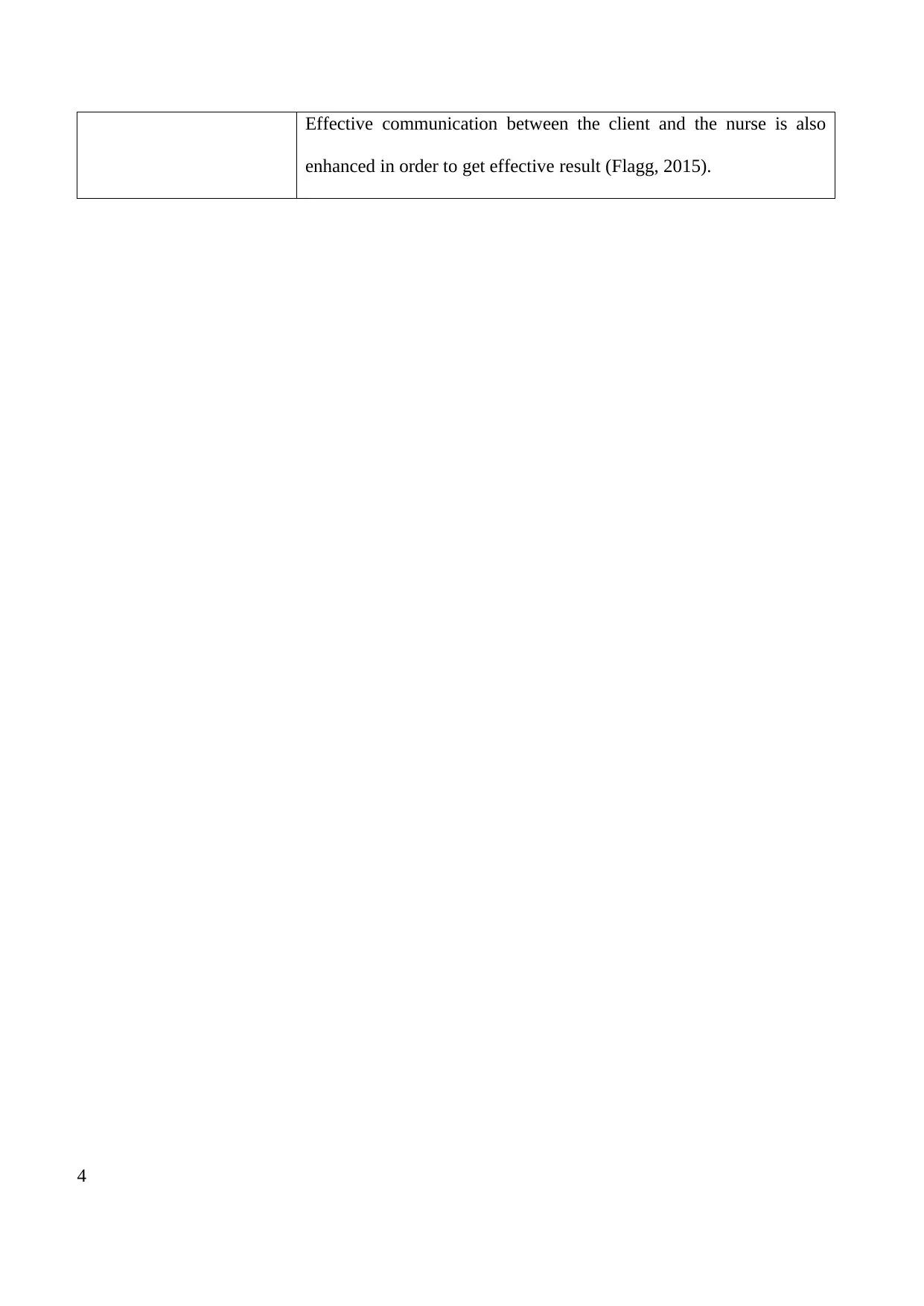
Effective communication between the client and the nurse is also
enhanced in order to get effective result (Flagg, 2015).
4
enhanced in order to get effective result (Flagg, 2015).
4
Secure Best Marks with AI Grader
Need help grading? Try our AI Grader for instant feedback on your assignments.
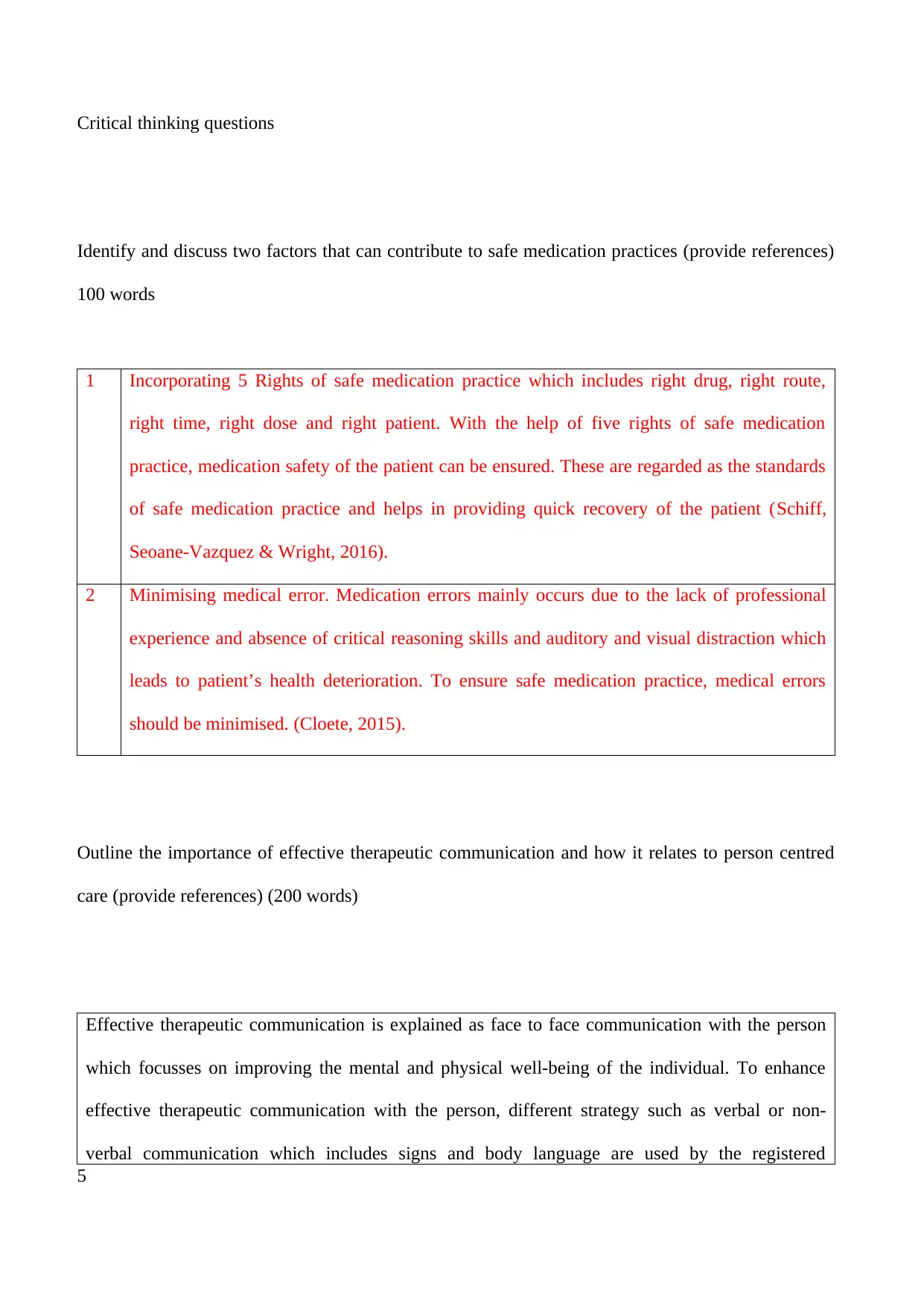
Critical thinking questions
Identify and discuss two factors that can contribute to safe medication practices (provide references)
100 words
1 Incorporating 5 Rights of safe medication practice which includes right drug, right route,
right time, right dose and right patient. With the help of five rights of safe medication
practice, medication safety of the patient can be ensured. These are regarded as the standards
of safe medication practice and helps in providing quick recovery of the patient (Schiff,
Seoane-Vazquez & Wright, 2016).
2 Minimising medical error. Medication errors mainly occurs due to the lack of professional
experience and absence of critical reasoning skills and auditory and visual distraction which
leads to patient’s health deterioration. To ensure safe medication practice, medical errors
should be minimised. (Cloete, 2015).
Outline the importance of effective therapeutic communication and how it relates to person centred
care (provide references) (200 words)
Effective therapeutic communication is explained as face to face communication with the person
which focusses on improving the mental and physical well-being of the individual. To enhance
effective therapeutic communication with the person, different strategy such as verbal or non-
verbal communication which includes signs and body language are used by the registered
5
Identify and discuss two factors that can contribute to safe medication practices (provide references)
100 words
1 Incorporating 5 Rights of safe medication practice which includes right drug, right route,
right time, right dose and right patient. With the help of five rights of safe medication
practice, medication safety of the patient can be ensured. These are regarded as the standards
of safe medication practice and helps in providing quick recovery of the patient (Schiff,
Seoane-Vazquez & Wright, 2016).
2 Minimising medical error. Medication errors mainly occurs due to the lack of professional
experience and absence of critical reasoning skills and auditory and visual distraction which
leads to patient’s health deterioration. To ensure safe medication practice, medical errors
should be minimised. (Cloete, 2015).
Outline the importance of effective therapeutic communication and how it relates to person centred
care (provide references) (200 words)
Effective therapeutic communication is explained as face to face communication with the person
which focusses on improving the mental and physical well-being of the individual. To enhance
effective therapeutic communication with the person, different strategy such as verbal or non-
verbal communication which includes signs and body language are used by the registered
5
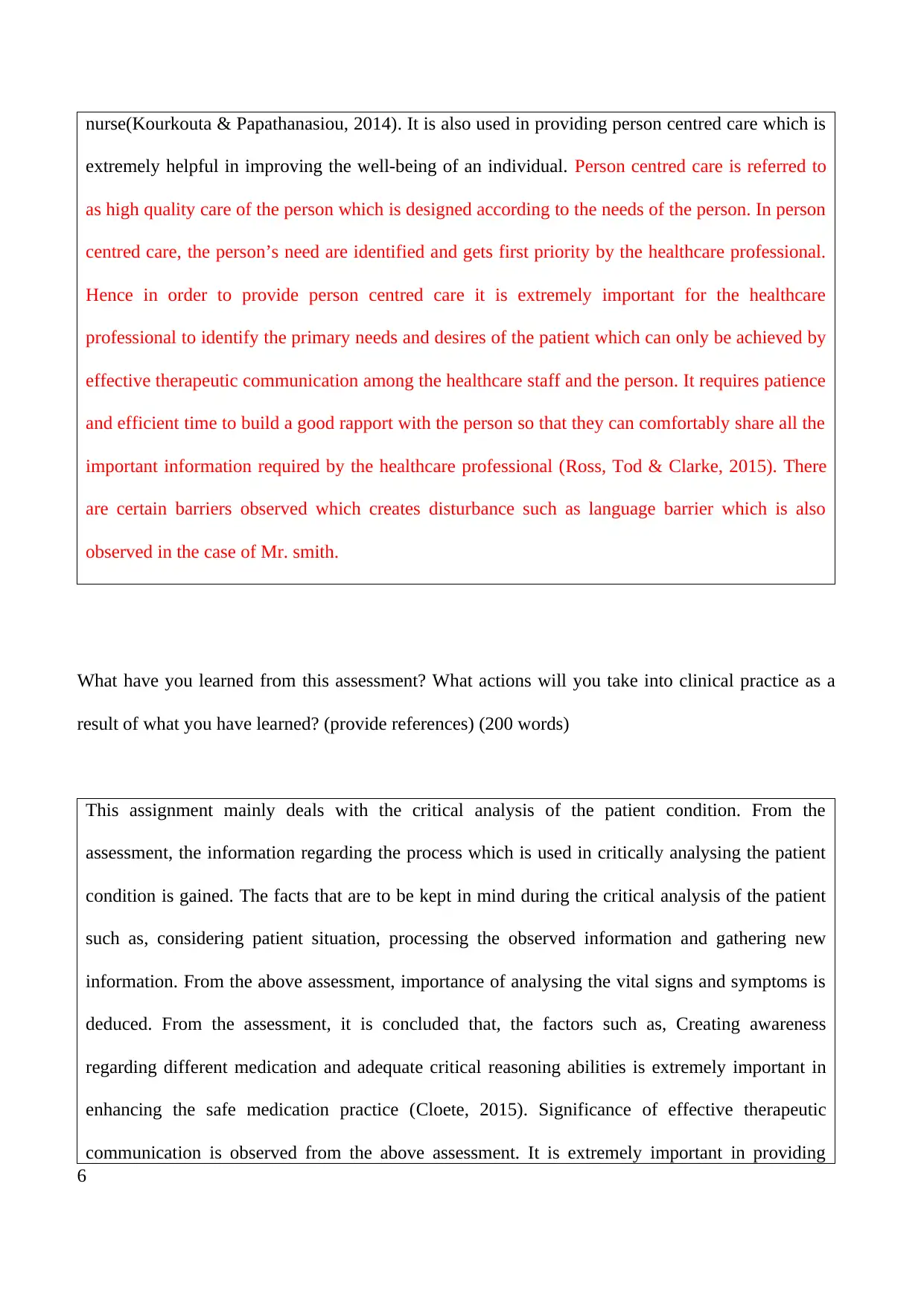
nurse(Kourkouta & Papathanasiou, 2014). It is also used in providing person centred care which is
extremely helpful in improving the well-being of an individual. Person centred care is referred to
as high quality care of the person which is designed according to the needs of the person. In person
centred care, the person’s need are identified and gets first priority by the healthcare professional.
Hence in order to provide person centred care it is extremely important for the healthcare
professional to identify the primary needs and desires of the patient which can only be achieved by
effective therapeutic communication among the healthcare staff and the person. It requires patience
and efficient time to build a good rapport with the person so that they can comfortably share all the
important information required by the healthcare professional (Ross, Tod & Clarke, 2015). There
are certain barriers observed which creates disturbance such as language barrier which is also
observed in the case of Mr. smith.
What have you learned from this assessment? What actions will you take into clinical practice as a
result of what you have learned? (provide references) (200 words)
This assignment mainly deals with the critical analysis of the patient condition. From the
assessment, the information regarding the process which is used in critically analysing the patient
condition is gained. The facts that are to be kept in mind during the critical analysis of the patient
such as, considering patient situation, processing the observed information and gathering new
information. From the above assessment, importance of analysing the vital signs and symptoms is
deduced. From the assessment, it is concluded that, the factors such as, Creating awareness
regarding different medication and adequate critical reasoning abilities is extremely important in
enhancing the safe medication practice (Cloete, 2015). Significance of effective therapeutic
communication is observed from the above assessment. It is extremely important in providing
6
extremely helpful in improving the well-being of an individual. Person centred care is referred to
as high quality care of the person which is designed according to the needs of the person. In person
centred care, the person’s need are identified and gets first priority by the healthcare professional.
Hence in order to provide person centred care it is extremely important for the healthcare
professional to identify the primary needs and desires of the patient which can only be achieved by
effective therapeutic communication among the healthcare staff and the person. It requires patience
and efficient time to build a good rapport with the person so that they can comfortably share all the
important information required by the healthcare professional (Ross, Tod & Clarke, 2015). There
are certain barriers observed which creates disturbance such as language barrier which is also
observed in the case of Mr. smith.
What have you learned from this assessment? What actions will you take into clinical practice as a
result of what you have learned? (provide references) (200 words)
This assignment mainly deals with the critical analysis of the patient condition. From the
assessment, the information regarding the process which is used in critically analysing the patient
condition is gained. The facts that are to be kept in mind during the critical analysis of the patient
such as, considering patient situation, processing the observed information and gathering new
information. From the above assessment, importance of analysing the vital signs and symptoms is
deduced. From the assessment, it is concluded that, the factors such as, Creating awareness
regarding different medication and adequate critical reasoning abilities is extremely important in
enhancing the safe medication practice (Cloete, 2015). Significance of effective therapeutic
communication is observed from the above assessment. It is extremely important in providing
6

effective patient care to the patient which lacks during the treatment of Mr smith as Cameron
(registered nurse) is unable to form an effective therapeutic relationship with Mr smith. Hence it is
very important for a nurse to form a healthy relationship with the client is order to get effective
result and better recovery (Riley, 2015). From the assessment, the information regarding the steps
or procedure that should be taken while handling the patient is evaluated.
7
(registered nurse) is unable to form an effective therapeutic relationship with Mr smith. Hence it is
very important for a nurse to form a healthy relationship with the client is order to get effective
result and better recovery (Riley, 2015). From the assessment, the information regarding the steps
or procedure that should be taken while handling the patient is evaluated.
7
Paraphrase This Document
Need a fresh take? Get an instant paraphrase of this document with our AI Paraphraser

References
Schiff, G., Seoane-Vazquez, E., & Wright, A. (2016). Incorporating indications into medication
ordering—time to enter the age of reason.
Cloete, L. (2015). Reducing medication errors in nursing practice. Cancer Nursing Practice, 14(1).
Cozma-Petruţ, A., Loghin, F., Miere, D., & Dumitraşcu, D. L. (2017). Diet in irritable bowel
syndrome: What to recommend, not what to forbid to patients!. World journal of
gastroenterology, 23(21), 3771.
Davies, M. J., Bergenstal, R., Bode, B., Kushner, R. F., Lewin, A., Skjøth, T. V., ... & DeFronzo, R.
A. (2015). Efficacy of liraglutide for weight loss among patients with type 2 diabetes: the
SCALE diabetes randomized clinical trial. Jama, 314(7), 687-699.
Ross, H., Tod, A. M., & Clarke, A. (2015). Understanding and achieving person‐centred care: the
nurse perspective. Journal of Clinical Nursing, 24(9-10), 1223-1233.
Koenig, J., Jarczok, M. N., Ellis, R. J., Hillecke, T. K., & Thayer, J. F. (2014). Heart rate variability
and experimentally induced pain in healthy adults: a systematic review. European Journal of
Pain, 18(3), 301-314.
Kourkouta, L., & Papathanasiou, I. V. (2014). Communication in nursing practice. Materia socio-
medica, 26(1), 65.
Riley, J. B. (2015). Communication in nursing. Elsevier Health Sciences.
8
Schiff, G., Seoane-Vazquez, E., & Wright, A. (2016). Incorporating indications into medication
ordering—time to enter the age of reason.
Cloete, L. (2015). Reducing medication errors in nursing practice. Cancer Nursing Practice, 14(1).
Cozma-Petruţ, A., Loghin, F., Miere, D., & Dumitraşcu, D. L. (2017). Diet in irritable bowel
syndrome: What to recommend, not what to forbid to patients!. World journal of
gastroenterology, 23(21), 3771.
Davies, M. J., Bergenstal, R., Bode, B., Kushner, R. F., Lewin, A., Skjøth, T. V., ... & DeFronzo, R.
A. (2015). Efficacy of liraglutide for weight loss among patients with type 2 diabetes: the
SCALE diabetes randomized clinical trial. Jama, 314(7), 687-699.
Ross, H., Tod, A. M., & Clarke, A. (2015). Understanding and achieving person‐centred care: the
nurse perspective. Journal of Clinical Nursing, 24(9-10), 1223-1233.
Koenig, J., Jarczok, M. N., Ellis, R. J., Hillecke, T. K., & Thayer, J. F. (2014). Heart rate variability
and experimentally induced pain in healthy adults: a systematic review. European Journal of
Pain, 18(3), 301-314.
Kourkouta, L., & Papathanasiou, I. V. (2014). Communication in nursing practice. Materia socio-
medica, 26(1), 65.
Riley, J. B. (2015). Communication in nursing. Elsevier Health Sciences.
8
1 out of 8
Related Documents
Your All-in-One AI-Powered Toolkit for Academic Success.
+13062052269
info@desklib.com
Available 24*7 on WhatsApp / Email
![[object Object]](/_next/static/media/star-bottom.7253800d.svg)
Unlock your academic potential
© 2024 | Zucol Services PVT LTD | All rights reserved.





